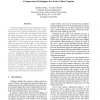Free Online Productivity Tools
i2Speak
i2Symbol
i2OCR
iTex2Img
iWeb2Print
iWeb2Shot
i2Type
iPdf2Split
iPdf2Merge
i2Bopomofo
i2Arabic
i2Style
i2Image
i2PDF
iLatex2Rtf
Sci2ools
DCC
2002
IEEE
2002
IEEE
Compression Techniques for Active Video Content
Conventional digital video playback systems provide only limited user interactivity, mostly in the form of VCRlike controls such as fast forward/backward, slow motion, pause/stop, etc. In this model, the temporal ordering and the spatial viewpoints of the video streams being viewed are completely determined at authoring time. In contrast, we have defined a form of interactive video called active video [NEO01], which supports hyper-linking among related video sequences and interpolation of video sequences with neighboring viewpoints, to offer end users the additional flexibility of choosing the sequencing and the viewing angle (even virtual ones) at playback time, respectively. However, flexibility of spatial navigation in active video leads to a substantially higher storage and transmission cost due to multiple time-synchronized video streams capturing the same scene and the meta-data encoding their spatial association. In fact, since the meta-data cost is comparable to that of video ...
| Added | 25 Dec 2009 |
| Updated | 25 Dec 2009 |
| Type | Conference |
| Year | 2002 |
| Where | DCC |
| Authors | Anindya Neogi, Tzi-cker Chiueh |
Comments (0)

